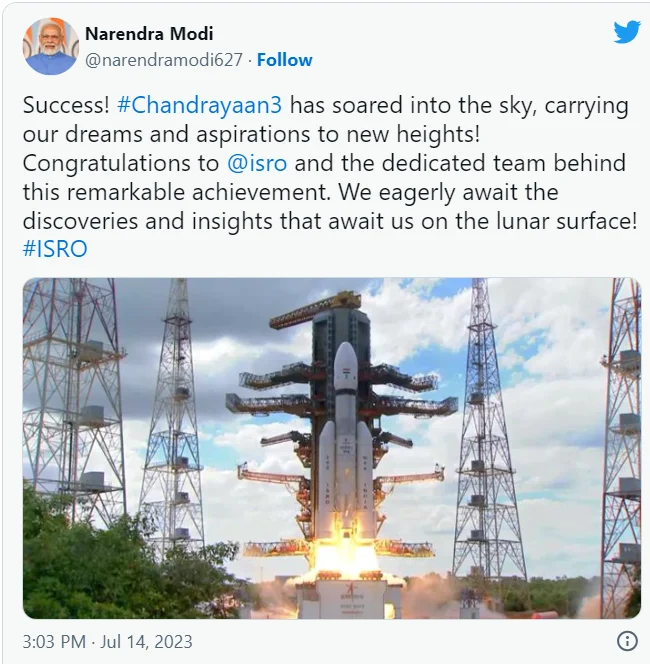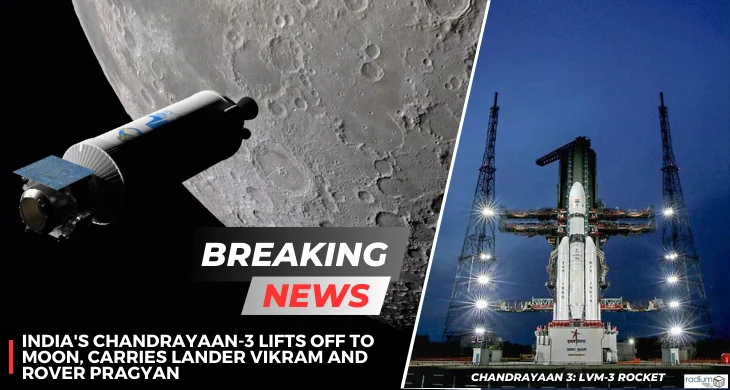Sriharikota: The Third lunar Mission of the Indian Space Research Organization (ISRO) ,Called Chandrayaan-3 ,achieved a Successful Liftoff to Great Applause from the Second Launch Pad at the Satish Dhawan Space Centre in Srihari kota ,AndhraPradesh ,India.
While this marks India’s third endeavor to explore the moon ,it is the second try to achieve a controlled landing at the lunar south pole. The primary objective of this mission ,known as Chandrayaan-3 ,is to demonstrate and evaluate the landing and roving capabilities. The mission includes a lander named Vikram ,which is scheduled to make a touchdown on August 23rd.
Chandrayaan-3 LVM-3 rocket
The “Mooncraft” mission is the third lunar exploration endeavor Conducted by the Indian Space Research Organization (ISRO). Unlike its predecessor ,Chandrayaan-2 ,this mission comprises a lander and a rover but does not include an orbiter. The propulsion module of the spacecraft functions as a communication relay satellite. It carries the lander and rover setup until the spacecraft reaches a lunar orbit of 100 km. The mission was launched on June 14 ,2023 ,at 14:35 Indian Standard Time (IST).
After encountering a software glitch in the soft landing guidance software during Chandrayaan-2 ,which resulted in the failure of the lander’s attempted soft landing despite a successful orbital insertion ,a subsequent lunar mission was proposed.
On July 14, 2023 ,at 2:35 pm Indian Standard Time (IST) ,Chandrayaan-3 was launched, successfully achieving the injection into a 100 km circular polar orbit ,marking the completion of phase one. The anticipated landing of the rover on the moon is scheduled for August 23 ,2023.
Background
As part of the second phase of the Chandrayaan program ,aimed at showcasing a soft landing on the Moon ,ISRO initiated the launch of Chandrayaan-2. The mission employed the Launch Vehicle Mark-3 (LVM 3) to carry an orbiter ,a lander ,and a rover. The planned touchdown of the lander on the lunar surface was scheduled for September 2019 ,with the objective of deploying the Pragyan rover.
Previous reports indicated a potential collaboration between India and Japan for a mission to the lunar south pole. In this joint effort, India was set to contribute the lander, while Japan would provide both the launcher and the rover. The mission’s objectives may encompass site sampling and the development of lunar night survival technologies.
Following the unsuccessful landing of the Vikram lander ,efforts were redirected towards a new mission aimed at showcasing the necessary landing capabilities for the proposed Lunar Polar Exploration Mission in partnership with Japan ,scheduled for 2025. For mission-critical flight operations, the European Space Tracking (ESTRACK) ,operated by the European Space Agency (ESA) ,has been contracted to provide support.
Objective
ISRO has set three main objectives for the Chandrayaan-3 mission, which includes:
- The Primary Objective is to achieve a safe and Gentle landing of a lander on the Surface of the Moon.
- Observing and demonstrating the rover’s loitering capabilities on the Moon
3. The Mission Aims to conduct scientific observations on the Moon’s surface ,performing Experiments on the chemical and natural elements found in the Soil ,Water ,and other resources. This will enhance our understanding of the Moon’s composition. The term “interplanetary” refers to the Development and testing of new technologies necessary for missions involving travel between different planets.
Design
Chandrayaan-3 comprises three main components
Propulsion Module
Chandrayaan-3 Propulsion Module
The propulsion module will transport the lander and rover configuration until it reaches a lunar orbit of 100 km. It is designed as a box-like structure, featuring a single large solar panel attached to one side and a prominent cylinder known as the Intermodular Adapter Cone on top. This cylinder serves as a mounting structure for the lander. Alongside the lander, the module also carries a payload called SHAPE (Spectro-polarimetry of Habitable Planet Earth) to conduct spectral and polarimetric measurements of Earth from its lunar orbit.
Lander
Chandrayaan-3 Lander
The lander plays a crucial role in achieving a soft landing on the Moon. It is designed in a box-shaped structure and equipped with four landing legs and four landing thrusters, each generating 800 newtons of thrust. The lander will carry the rover as well as a diverse range of scientific instruments ,enabling in-site analysis and experiments.
The lander designed for Chandrayaan-3 will feature four throttle-able engines, differing from the previous Chandrayaan-2’s lander, Vikram, which had five engines generating 800 Newtons of thrust, including a centrally mounted engine with fixed thrust. Furthermore, the Chandrayaan-3 lander will be equipped with a Laser Doppler Velocimeter (LDV) for enhanced functionality. The impact legs of the lander have been reinforced, providing increased strength compared to Chandrayaan-2, and there is greater instrumentation redundancy. ISRO is focused on improving the structural rigidity and incorporating multiple contingency systems.
Rover
Chandrayaan-3 Rover
Chandrayaan-3 Rover Overview:
- Six-wheeled design
- Weight of 26 kilograms (57 pounds)
- Range of 500 meters (1,640 feet)
- Scientific instruments including cameras, spectrometers, and a drill
- Expected lifespan of one lunar day (14 Earth days)
- Communication with the lander and ground control team in India
The Chandrayaan-3 Rover is expected to make a number of important scientific discoveries, including:
- The composition of the lunar surface
- The presence of water ice in the lunar soil
- The history of lunar impacts
- The evolution of the Moon’s atmosphere
‘Chandrayaan 3’:PM Modi Tweet
As the spacecraft embarked on its journey, Twitter was inundated with videos and images capturing the momentous lift-off. Netizens expressed their overwhelming support and enthusiasm for the mission, hoping for a successful outcome this time.
Prime Minister Narendra Modi took to his official Twitter account to commend the extraordinary accomplishment. Alongside sharing a video of the launch, he expressed, “Success! #Chandrayaan3 has taken flight, carrying our dreams and aspirations to new heights! Congratulations to @isro and the dedicated team behind this remarkable achievement. We eagerly anticipate the discoveries and insights that await us on the lunar surface! #ISRO”

Funding
In December 2019 ,it was Announced that ISRO had submitted a request for the initial funding of the Project ,Totaling ₹75 crore (US$9.4 million). Of this Amount ,₹60 crore (US$7.5 million) was Allocated for Expenses related to Machinery ,Equipment ,and other Capital Expenditure ,while the remaining ₹15 crore (US$1.9 million) was Designated for revenue Expenditure.
ISRO’s former chairman, K. Sivan, confirmed the existence of the project and stated that the estimated cost would be around ₹615 crore (equivalent to ₹721 crore or US$90 million in 2023).

